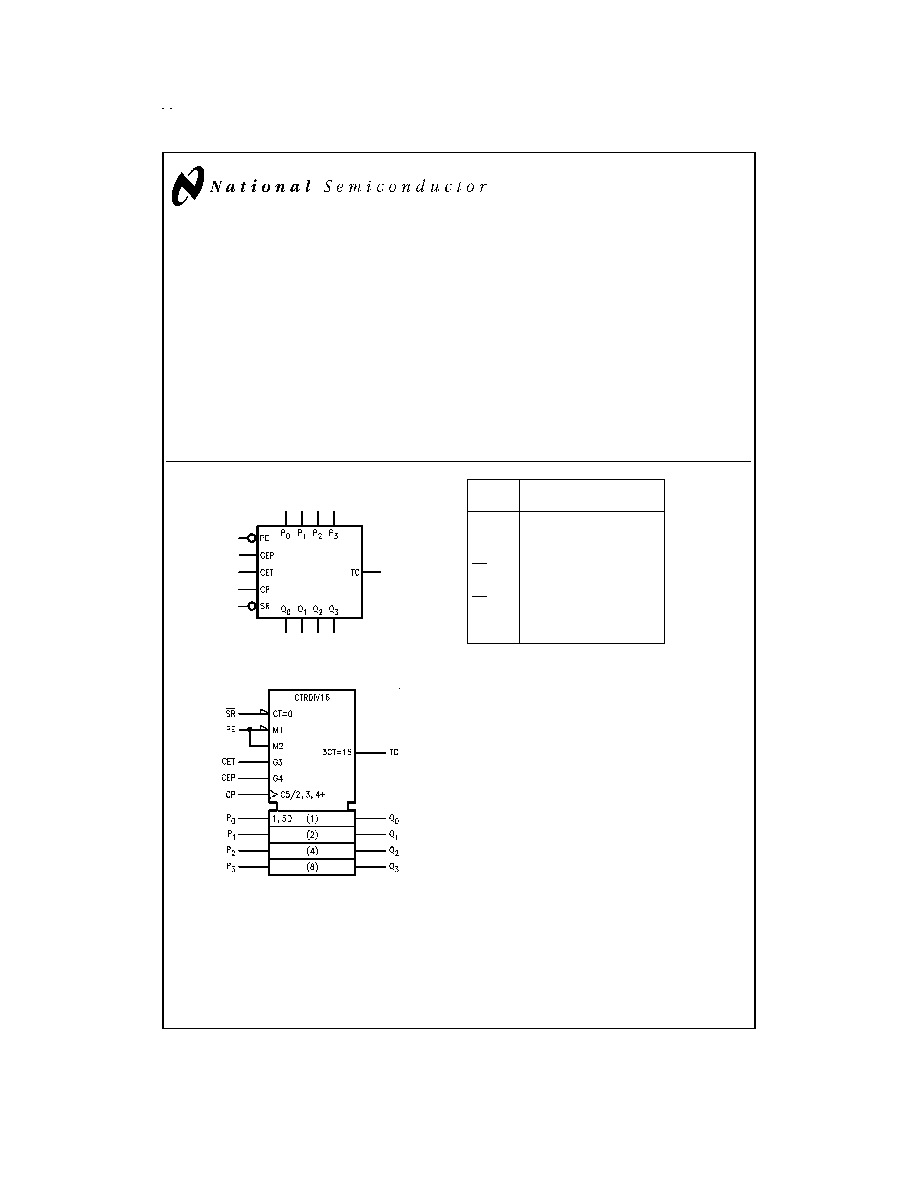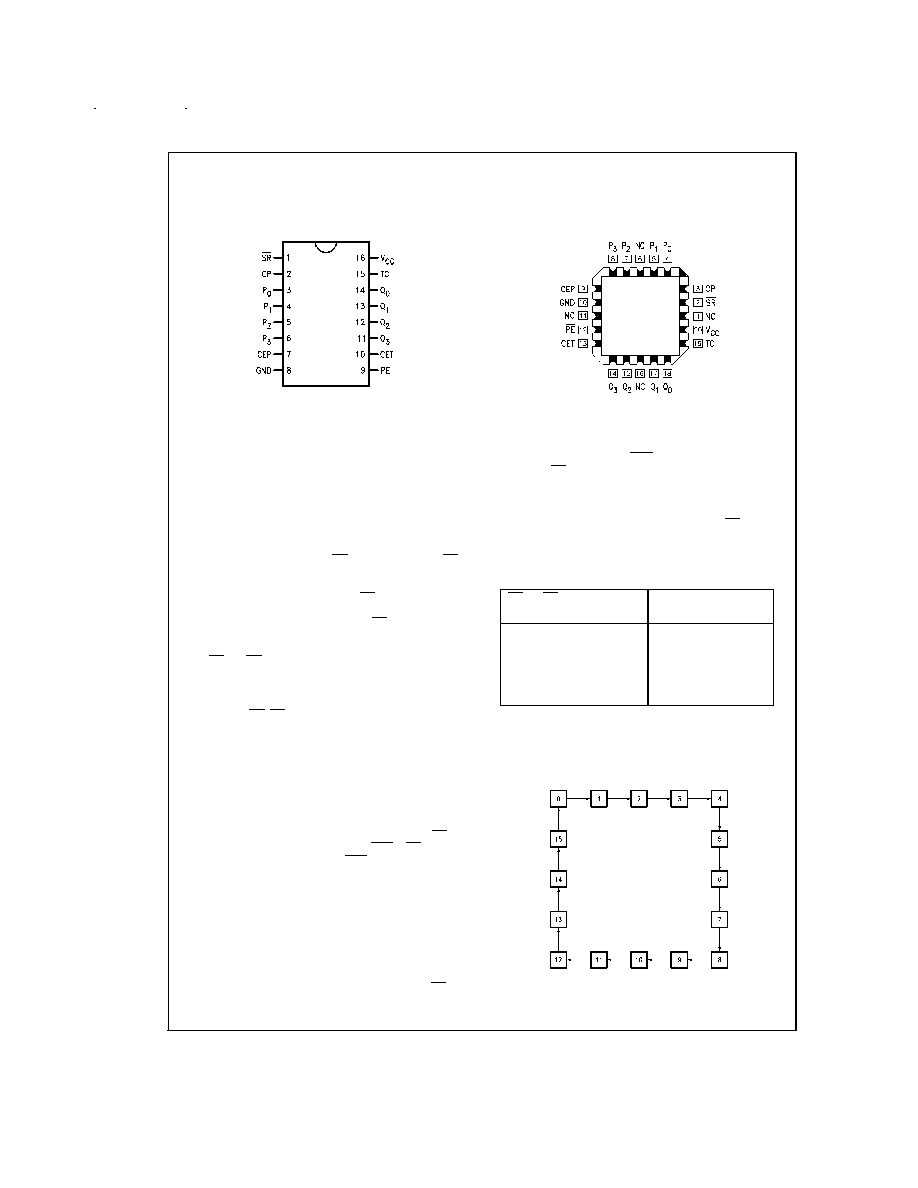
54AC163
∑
54ACT163
Synchronous Presettable Binary Counter
General Description
The 'AC/'ACT163 are high-speed synchronous modulo-16
binary counters. They are synchronously presettable for ap-
plication in programmable dividers and have two types of
Count Enable inputs plus a Terminal Count output for versa-
tility in forming synchronous multistage counters. The 'AC/
'ACT163 has a Synchronous Reset input that overrides
counting and parallel loading and allows the outputs to be si-
multaneously reset on the rising edge of the clock.
Features
n
I
CC
reduced by 50%
n
Synchronous counting and loading
n
High-speed synchronous expansion
n
Typical count rate of 125 MHz
n
Outputs source/sink 24 mA
n
'ACT163 has TTL-compatible inputs
n
Standard Microcircuit Drawing (SMD)
-- 'AC163: 5962-89582
-- 'ACT163: 5962-91723
Logic Symbols
Pin
Names
Description
CEP
Count Enable Parallel Input
CET
Count Enable Trickle Input
CP
Clock Pulse Input
SR
Synchronous Reset Input
P
0
≠P
3
Parallel Data Inputs
PE
Parallel Enable Input
Q
0
≠Q
3
Flip-Flop Outputs
TC
Terminal Count Output
FACT
TM
is a trademark of Fairchild Semiconductor Corporation.
DS100275-1
IEEE/IEC
DS100275-2
November 1998
54AC163
∑
54ACT163
Synchronous
Presettable
Binary
Counter
© 1998 National Semiconductor Corporation
DS100275
www.national.com

Connection Diagrams
Functional Description
The 'AC/'ACT163 counts in modulo-16 binary sequence.
From state 15 (HHHH) it increments to state 0 (LLLL). The
clock inputs of all flip-flops are driven in parallel through a
clock buffer. Thus all changes of the Q outputs occur as a re-
sult of, and synchronous with, the LOW-to-HIGH transition of
the CP input signal. The circuits have four fundamental
modes of operation, in order of precedence: synchronous re-
set,
parallel
load,
count-up
and
hold.
Four
control
inputs -- Synchronous Reset (SR), Parallel Enable (PE),
Count Enable Parallel (CEP) and Count Enable Trickle
(CET) -- determine the mode of operation, as shown in the
Mode Select Table. A LOW signal on SR overrides counting
and parallel loading and allows all outputs to go LOW on the
next rising edge of CP. A LOW signal on PE overrides count-
ing and allows information on the Parallel Data (P
n
) inputs to
be loaded into the flip-flops on the next rising edge of CP.
With PE and SR HIGH, CEP and CET permit counting when
both are HIGH. Conversely, a LOW signal on either CEP or
CET inhibits counting.
The 'AC/'ACT163 uses D-type edge-triggered flip-flops and
changing the SR, PE, CEP and CET inputs when the CP is
in either state does not cause errors, provided that the rec-
ommended setup and hold times, with respect to the rising
edge of CP, are observed.
The Terminal Count (TC) output is HIGH when CET is HIGH
and counter is in state 15. To implement synchronous multi-
stage counters, the TC outputs can be used with the CEP
and CET inputs in two different ways.
Figure 1 shows the connections for simple ripple carry, in
which the clock period must be longer than the CP to TC de-
lay of the first stage, plus the cumulative CET to TC delays of
the intermediate stages, plus the CET to CP setup time of
the last stage. This total delay plus setup time sets the upper
limit on clock frequency. For faster clock rates, the carry loo-
kahead connections shown in
Figure 2 are recommended. In
this scheme the ripple delay through the intermediate stages
commences with the same clock that causes the first stage
to tick over from max to min in the Up mode, or min to max
in the Down mode, to start its final cycle. Since this final
cycle takes 16 clocks to complete, there is plenty of time for
the ripple to progress through the intermediate stages. The
critical timing that limits the clock period is the CP to TC de-
lay of the first stage plus the CEP to CP setup time of the last
stage. The TC output is subject to decoding spikes due to in-
ternal race conditions and is therefore not recommended for
use as a clock or asynchronous reset for flip-flops, registers
or counters.
Logic Equations: Count Enable = CEP
∑ CET ∑ PE
TC = Q
0
∑ Q
1
∑ Q
2
∑ Q
3
∑ CET
Mode Select Table
SR
PE
CET
CEP
Action on the Rising
Clock Edge (
N
)
L
X
X
X
Reset (Clear)
H
L
X
X
Load (P
n
Q
n
)
H
H
H
H
Count (Increment)
H
H
L
X
No Change (Hold)
H
H
X
L
No Change (Hold)
H = HIGH Voltage Level
L = LOW Voltage Level
X = Immaterial
State Diagram
Pin Assignment
for DIP and Flatpak
DS100275-3
Pin Assignment
for LCC
DS100275-4
DS100275-5
www.national.com
2

Absolute Maximum Ratings
(Note 1)
If Military/Aerospace specified devices are required,
please contact the National Semiconductor Sales Office/
Distributors for availability and specifications.
Supply Voltage (V
CC
)
-0.5V to +7.0V
DC Input Diode Current (I
IK
)
V
I
= -0.5V
-20 mA
V
I
= V
CC
+ 0.5V
+20 mA
DC Input Voltage (V
I
)
-0.5V to V
CC
+ 0.5V
DC Output Diode Current (I
OK
)
V
O
= -0.5V
-20 mA
V
O
= V
CC
+ 0.5V
+20 mA
DC Output Voltage (V
O
)
-0.5V to V
CC
+ 0.5V
DC Output Source
or Sink Current (I
O
)
±
50 mA
DC V
CC
or Ground Current
per Output Pin (I
CC
or I
GND
)
±
50 mA
Storage Temperature (T
STG
)
-65∞C to +150∞C
Junction Temperature (T
J
)
CDIP
175∞C
Recommended Operating
Conditions
Supply Voltage (V
CC
)
'AC
2.0V to 6.0V
'ACT
4.5V to 5.5V
Input Voltage (V
I
)
0V to V
CC
Output Voltage (V
O
)
0V to V
CC
Operating Temperature (T
A
)
54AC/ACT
-55∞C to +125∞C
Minimum Input Edge Rate (
V/
t)
'AC Devices
V
IN
from 30% to 70% of V
CC
V
CC
@
3.3V, 4.5V, 5.5V
125 mV/ns
Minimum Input Edge Rate (
V/
t)
'ACT Devices
V
IN
from 0.8V to 2.0V
V
CC
@
4.5V, 5.5V
125 mV/ns
Note 1: Absolute maximum ratings are those values beyond which damage
to the device may occur. The databook specifications should be met, without
exception, to ensure that the system design is reliable over its power supply,
temperature, and output/input loading variables. National does not recom-
mend operation of FACT
TM
circuits outside databook specifications.
DC Characteristics for 'AC Family Devices
54AC
Symbol
Parameter
V
CC
T
A
=
Units
Conditions
(V)
-55∞C to +125∞C
Guaranteed
Limits
V
IH
Minimum High Level
3.0
2.1
V
OUT
= 0.1V
Input Voltage
4.5
3.15
V
or V
CC
- 0.1V
5.5
3.85
V
IL
Maximum Low Level
3.0
0.9
V
OUT
= 0.1V
Input Voltage
4.5
1.35
V
or V
CC
- 0.1V
5.5
1.65
V
OH
Minimum High Level
3.0
2.9
I
OUT
= -50 µA
Output Voltage
4.5
4.4
V
5.5
5.4
(Note 2)
V
IN
= V
IL
or V
IH
3.0
2.4
I
OH
= -12 mA
4.5
3.7
V
I
OH
= -24 mA
5.5
4.7
I
OH
= -24 mA
V
OL
Maximum Low Level
3.0
0.1
I
OUT
= 50 µA
Output Voltage
4.5
0.1
V
5.5
0.1
(Note 2)
V
IN
= V
IL
or V
IH
3.0
0.50
I
OL
= 12 mA
4.5
0.50
V
I
OL
= 24 mA
5.5
0.50
I
OL
= 24 mA
I
IN
Maximum Input
5.5
±
1.0
µA
V
I
= V
CC
, GND
Leakage Current
I
OLD
Minimum Dynamic
Output Current (Note 3)
5.5
50
mA
V
OLD
= 1.65V Max
I
OHD
5.5
-50
mA
V
OHD
= 3.85V Min
www.national.com
5




